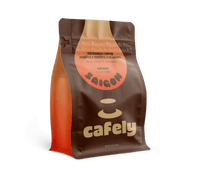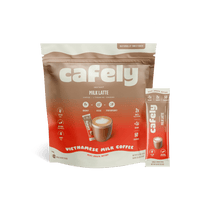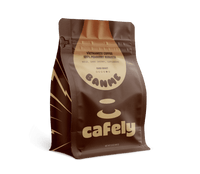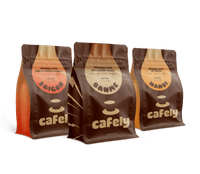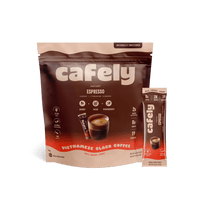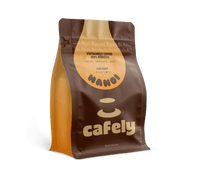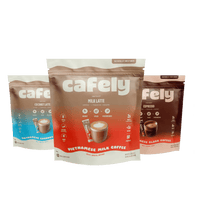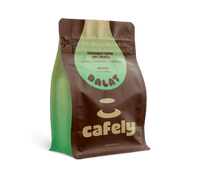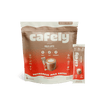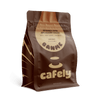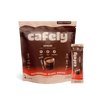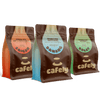Coffee molds are types of mold that can develop on coffee beans when they’re stored or processed improperly.
These molds can produce something called mycotoxins — this just means a toxin produced by a mold. Mycotoxins from coffee beans can make it into your final drink, so the effects are very important to remember [1].
We’re going to break down our top three recommendations for top-notch mold-free coffees, as well as describe the science behind them. We’ll talk about what coffee mold is, how it may affect you, and how to tell if your coffee has it.
Top 3 Mold-Free Coffees: Keep Your Cup of Joe Clean, Pure, & Delicious
Let’s run through three of our top recommendations for mold-free coffee.
All Cafely coffee is tested for mycotoxins — it’s important to us that the product we’re sending out into the world is top-quality and contains no unhealthy or harmful chemicals. But if we had to pick three to recommend to you for a clean, flavorful cup, we’d have to go with these.
1. SaiGon OG (Traditional Vietnamese Roast)
 This showcase of three Vietnamese varietals is our flagship blend, using robusta, arabica, and peaberry. The unique characteristics of these beans give the coffee a distinctive flavor that’s a heartfelt tribute to the modern coffee scene in Saigon, now called Ho Chi Minh City, in Vietnam.
This showcase of three Vietnamese varietals is our flagship blend, using robusta, arabica, and peaberry. The unique characteristics of these beans give the coffee a distinctive flavor that’s a heartfelt tribute to the modern coffee scene in Saigon, now called Ho Chi Minh City, in Vietnam.
The inclusion of robusta beans and a traditional butter roast provides a velvety cup with a bold, full body and flavor. Peaberry brings strength and richness, while the light and more complex flavors of arabica hold everything together in a harmonious balance.
When it comes to being mold-free, as with all Cafely coffee, these beans have been thoroughly tested for mycotoxins. On top of that, a one-way valve on the bag is used to ensure no moisture forms within the bag of beans to prevent mold formation. Finally, the complex, dark roast of these SaiGon OG beans has been shown to greatly reduce fungi and mycotoxins [2].
2. BanMe Coffee (100% Peaberry)
 BanMe is a true powerhouse of coffee. Why? Its beans are entirely peaberry robusta. To quickly explain: a peaberry coffee bean is one where a rare genetic mutation occurred in the cherry. This meant that rather than two beans being formed as in a typical coffee fruit, just one developed — a peaberry coffee bean.
BanMe is a true powerhouse of coffee. Why? Its beans are entirely peaberry robusta. To quickly explain: a peaberry coffee bean is one where a rare genetic mutation occurred in the cherry. This meant that rather than two beans being formed as in a typical coffee fruit, just one developed — a peaberry coffee bean.
These beans are considered to have a smoother, richer flavor than their regular cousins. Since robusta coffee beans already have a dark, strong flavor, peaberry robusta beans are thought to have an even darker and stronger taste than that!
When we say they are strong, we mean it. Peaberries are the beans that have the most caffeine out of all the varietals. Robusta already has more caffeine than regular arabica coffee, and peaberry cherries concentrate all of their nutrients into one bean rather than two, leading to a truly potent little bean.
Finally, in terms of the safety of these beans, they are tested for mycotoxin levels and other types of mold. A one-way valve is also used to massively reduce the chances of any mold forming after the tests are completed.
3. Vietnamese Coffee 2.0
 These sachets are a great way to get a hit of Vietnamese-style coffee in no time at all. They’re available in three flavors: black, milk latte, and coconut latte, giving you a taste of all that Vietnamese coffee has to offer. Savor rich, dark, black coffee and enjoy the sweetened and delicate flavors available in the coconut latte.
These sachets are a great way to get a hit of Vietnamese-style coffee in no time at all. They’re available in three flavors: black, milk latte, and coconut latte, giving you a taste of all that Vietnamese coffee has to offer. Savor rich, dark, black coffee and enjoy the sweetened and delicate flavors available in the coconut latte.
As with all other Cafely products, these are thoroughly tested for mold and mycotoxins to ensure that they’re totally safe to drink. In addition, each sachet is heat-sealed to ensure that it’s totally airtight — the contents remain sterile from the factory to your cup and cannot be contaminated unless the sachet is opened.
The sachets also make use of some tasty and impressive adaptogens to give you a boost with each cup. The headlining adaptogens are ginseng and L-theanine. These may benefit brain function [3] and focus [4], respectively: just what you want out of your cup of morning coffee.
What Molds Affect Coffee?
A lot of different molds may interact with coffee between the field and your cup. However, two types of mold, in particular, may interact with your coffee beans. These molds can produce mycotoxins, which are harmful chemicals that can impact you.
We’ve broken down the types of mold and their respective mycotoxins below.
|
Mold |
Mycotoxin(s) produced |
Mycotoxin(s) impact on health |
Mycotoxin(s) impact on coffee |
|
Aspergillus [5] |
Ochratoxin A (OTA), Aflatoxin B1 (AFB1) [6] |
OTA: See below. AFB1: Carcinogenic, organ and tissue damage, potential neurotoxicity. [7] |
OTA: See below. AFB1: It can damage the flavor of coffee overall, leading to spoiled and unpleasant coffee. [8] |
|
Penicillium [9] |
Ochratoxin A (OTA) [10] |
OTA: Kidney damage, liver damage, DNA damage [11] |
OTA: It may cause a decrease in the overall quality of your coffee. [12] |
How to Tell if Your Coffee Is Moldy
It can be supremely difficult to tell if coffee is moldy because beans from one batch to another can look wildly different. For instance, one batch may have a slightly higher amount of papery husk remaining after roasting, leading to a difference in color and shape in the beans.
Basically, to the untrained eye, it can be hard to determine what’s the result of mold, and what’s simply a low-quality coffee.
Thankfully, a cup of coffee is typically quite acidic, especially compared to other food and drinks. The reason this is good news is that many types of mold and bacteria cannot survive in these conditions, so your coffee is safer than you may think. Explore the best low-acid coffee options to enjoy a gentler brew.
Here are three ways to tell if your coffee is moldy:
Foul Taste
Sometimes, you may only realize that coffee is spoiled if you get sick from drinking it. This isn’t ideal, but at least you know to get rid of it!
Moldy coffee typically has the following taste characteristics:
- Musty or damp flavor
- Sour or overly bitter notes
- Earthy flavors that seem unnatural or overpowering
- Metallic or chemical-like aftertaste
Side Effects
One way to know if your coffee is moldy is if it makes you feel sick. Some of the symptoms that can arise after drinking moldy coffee include:
- Nausea
- Diarrhea
- Vomiting
- Stomach cramps
- Allergy flareups
- Fatigue
This is essentially your body responding to the food and attempting to get it out of your system.
If you experience any of these symptoms, they should dissipate fairly quickly, with very bad cases lasting up to a week. If your symptoms last for more than 72 hours, seek medical attention.
Visual Signs
Unfortunately, it's pretty difficult to actually "see" mold on your coffee in most cases. The molds that infect coffee blend in with the dark color of the beans and typically live inside the beans.
With that said, there are some things you can look for:
Look for these visual indicators of mold in your coffee:
- White, green, or blue fuzzy patches on whole beans or grounds
- Clumping in coffee grounds due to moisture exposure
- A dusty or powdery residue on beans
- An unusual discoloration, such as grayish or ashy hues
Summary: 5 Steps to Dectect Moldy Coffee Before You Drink It
There are a few key ways that you might be able to tell your coffee is on the way toward being a little past its prime.
- Aroma — Fresh coffee is powerfully aromatic, whereas stale coffee doesn’t have much of an aroma at all. Moldy coffee will likely smell musty or damp.
- Feel the texture of the grounds — Stale coffee will have lost its oiliness, so rub the grinds between your fingers and see if you can feel that oiliness there. Doing so with potentially moldy coffee may also alert you to white or blue spores hiding in the grounds.
- Look at the cup you brew — Because CO2 is released during brewing, fresh coffee should have crema or bloom going on. If you don’t have any of this, your coffee is likely stale or could have turned.
- Taste it — Fresh coffee is packed with flavor compounds that will lessen as the coffee becomes stale.
- Check the packaging — Check the roasting and best-before dates on the packaging to get an idea of how old the coffee is. The older it is, the more likely it is to be stale, and there is more risk of mold the longer the packet has been opened.
Side Effects of Drinking Moldy Coffee
As we mentioned above, there are two main mycotoxins in moldy coffee: aflatoxin b1 (AFB1) and ochratoxin a (OTA). These can have some specific impacts on your health, so let’s quickly address the issues they may give you.
AFB1
Aflatoxins can be quite nasty indeed, with their general symptoms including nausea and vomiting, as well as abdominal pain, convulsions, and acute liver injury. Over a longer period of time of consuming the mycotoxin, people can experience cirrhosis and hepatocellular carcinoma [7].
OTA
Less is generally known about the impact of OTA on humans. In animals, it’s known to cause renal tumors and nephrotoxicity, though, of course, humans digest things in very different ways from animals.
However, several studies have seen a link between OTA and different conditions that can cause kidney damage and failure. Namely, Balkan endemic nephropathy (BEN) and chronic interstitial nephropathy (CIN) [11].
It’s worth pointing out that these impacts are rare, so don’t panic! The main reason for this is that the vast majority of coffee in the world isn’t infected with these molds, and so never gets contaminated with these mycotoxins.
On top of this, even if you were to get some of these mycotoxins into your system accidentally, the extreme symptoms listed above are very unlikely to occur — coffee is very safe to drink.
Mycotoxin Testing
Mycotoxin testing can be a very complex field. However, whenever a company or certification board is testing for a given chemical, including for a specific mycotoxin, the most common method is a form of chromatography.
For mycotoxin testing specifically, affinity chromatography is used. This is quite a costly and labor-intensive process, but it’s the most reliable way to check for mycotoxins.
For mycotoxin testing in coffee beans, a sample of the beans will be crushed and suspended in a solvent, allowing all the chemicals to dissolve. Then, that solution is poured into a long container (similar to a test tube, but with a tap at the bottom to release the liquid) along with a chemical called binding matrix.
The mycotoxin, if it’s present, will bind to the binding matrix, and the rest of the sample is poured out.
Finally, the binding matrix is tested to see what chemicals are in it. For mycotoxins in coffee, companies will typically test for OTA and AFB1.
FAQs: Mold in Coffee
There can be a lot of confusion about science-heavy topics like this, so let's run through some key FAQs and boost our knowledge.
1. What Are Mycotoxins?
Mycotoxins are chemical toxins that are produced by molds and can be found in some crops if they are contaminated.
2. What Mycotoxins Can Be Found in Coffee?
There are many different mycotoxins in the world, but there are two which can be found in coffee. These are aflatoxin B1 (AFB1) and ochratoxin A (OTA).
3. How Can We Reduce Mycotoxin Presence in Coffee?
Growers have found many ways to reduce mycotoxin and mold presence in coffee beans. Most notably, wet processing is used to get rid of most molds and mycotoxins in beans. Also, roasting the beans kills molds that produce mycotoxins, with one study finding that the roasting process can reduce OTA levels by 69-96%. [13]
4. What Molds Can Be Found in Coffee Beans?
Two main molds can be found on coffee beans — aspergillus and penicillum [5, 9]. These are relevant because they can produce the mycotoxins OTA and AFB1 [6, 10].
5. Will Mycotoxins Build Up in Your System?
Thankfully, no, mycotoxins won’t build up in your system. This is because your liver is capable of neutralizing them.
6. How Safe Is Coffee Contaminated With These Mycotoxins?
While you may not want to drink coffee contaminated with anything, it’s reassuring to know that the levels of toxins in coffee beans and other grains are far below the safety limit.
References
- Heintz, M. M., Doepker, C. L., Wikoff, D. S., & Hawks, S. E. (2021). Assessing the food safety risk of ochratoxin A in coffee: A toxicology-based approach to food safety planning. Journal of Food Science, 86(11), 4799-4810.
- Attiya, W. A., Hassan, Z. U., Al-Thani, R., & Jaoua, S. (2021). Prevalence of toxigenic fungi and mycotoxins in Arabic coffee (Coffea arabica): Protective role of traditional coffee roasting, brewing and bacterial volatiles. PLoS ONE, 16(10).
- Jakaria, M., Haque, M. E., Kim, J., Cho, D. Y., Kim, I. S., & Choi, D. K. (2018). Active ginseng components in cognitive impairment: Therapeutic potential and prospects for delivery and clinical study. Oncotarget, 9(71), 33601–33620.
- Giesbrecht, T., Rycroft, J. A., Rowson, M. J., & De Bruin, E. A. (2010). The combination of L-theanine and caffeine improves cognitive performance and increases subjective alertness. Nutritional neuroscience, 13(6), 283–290.
- Navale, V., Vamkudoth, K. R., Ajmera, S., & Dhuri, V. (2021). Aspergillus derived mycotoxins in food and the environment: Prevalence, detection, and toxicity. Toxicology Reports, 8, 1008-1030.
- Anup Kodape, Atul Kodape, Exploring coffee's impact: Aflatoxins, phytochemicals, and public health considerations, Food Bioscience, Volume 61, 2024, 104991, ISSN 2212-4292
- Huang, B., Chen, Q., Wang, L., Gao, X., Zhu, W., Mu, P., & Deng, Y. (2020). Aflatoxin B1 Induces Neurotoxicity through Reactive Oxygen Species Generation, DNA Damage, Apoptosis, and S-Phase Cell Cycle Arrest. International Journal of Molecular Sciences, 21(18).
- Dhakal A, Hashmi MF, Sbar E. Aflatoxin Toxicity. [Updated 2023 Feb 19]. In: StatPearls [Internet]. Treasure Island (FL): StatPearls Publishing; 2024 Jan-.
- Perrone, G., & Susca, A. (2017). Penicillium Species and Their Associated Mycotoxins. Methods in molecular biology (Clifton, N.J.), 1542, 107–119.
- Reddy, L., & Bhoola, K. (2010). Ochratoxins—Food Contaminants: Impact on Human Health. Toxins, 2(4), 771-779.
- Bui-Klimke, T. R., & Wu, F. (2015). Ochratoxin A and human health risk: A review of the evidence. Critical Reviews in Food Science and Nutrition, 55(13), 1860.
- Yazdanfar, N., Mahmudiono, T., Fakhri, Y., Mahvi, A. H., Sadighara, P., Mohammadi, A. A., & Yousefi, M. (2022). Concentration of ochratoxin A in coffee products and probabilistic health risk assessment. Arabian Journal of Chemistry, 15(12), 104376.
- Karlovsky, P., Suman, M., Berthiller, F., De Meester, J., Eisenbrand, G., Perrin, I., Oswald, I. P., Speijers, G., Chiodini, A., Recker, T., & Dussort, P. (2016). Impact of food processing and detoxification treatments on mycotoxin contamination. Mycotoxin research, 32(4), 179–205.
